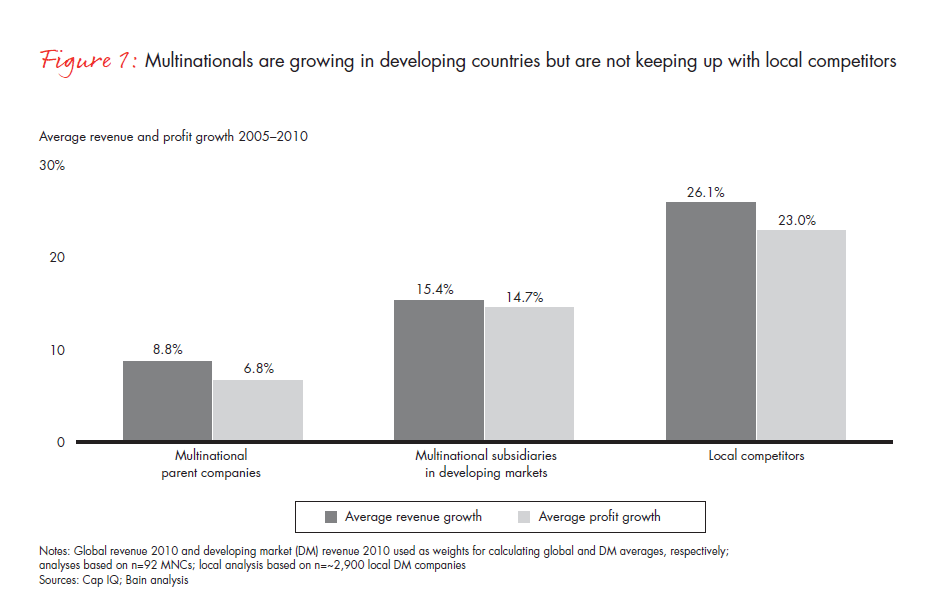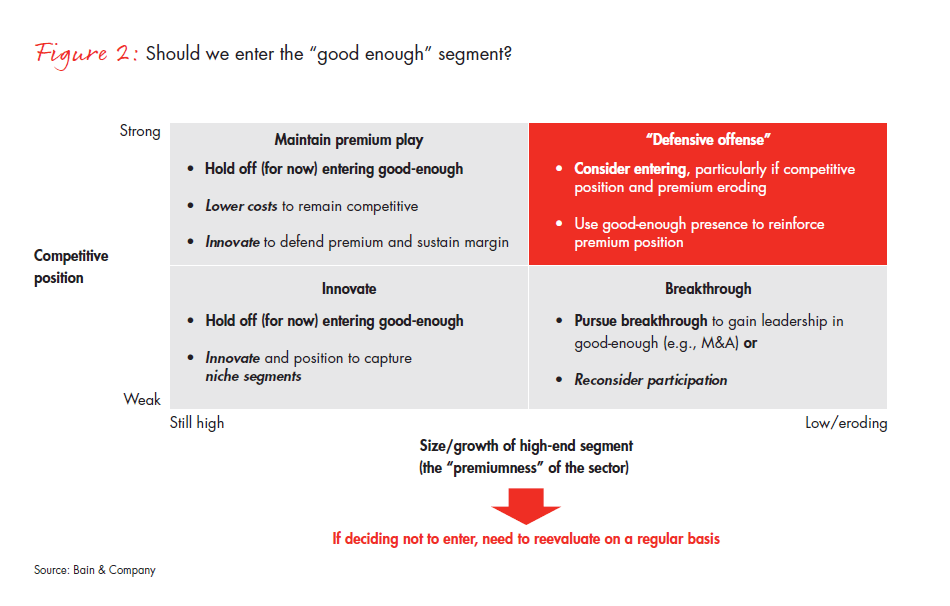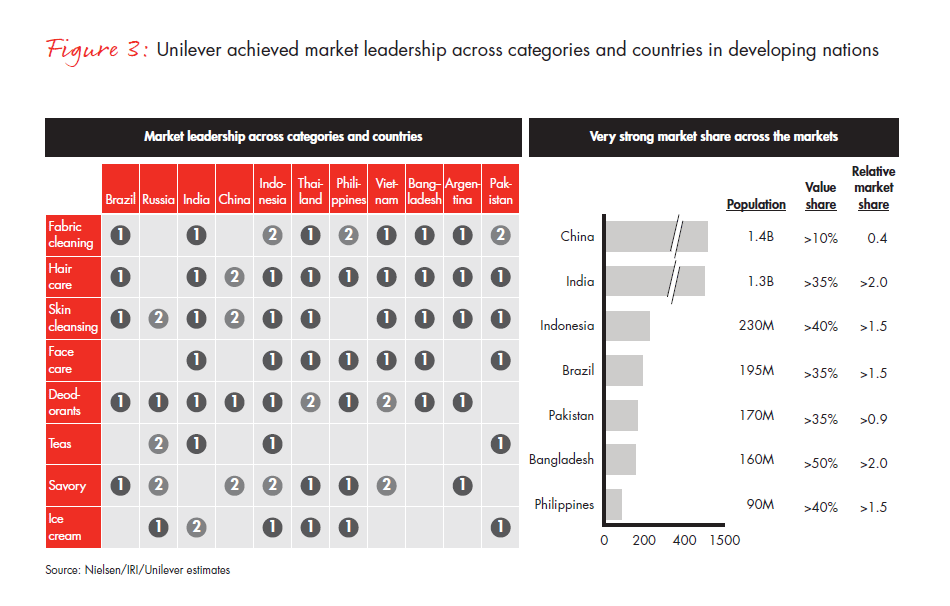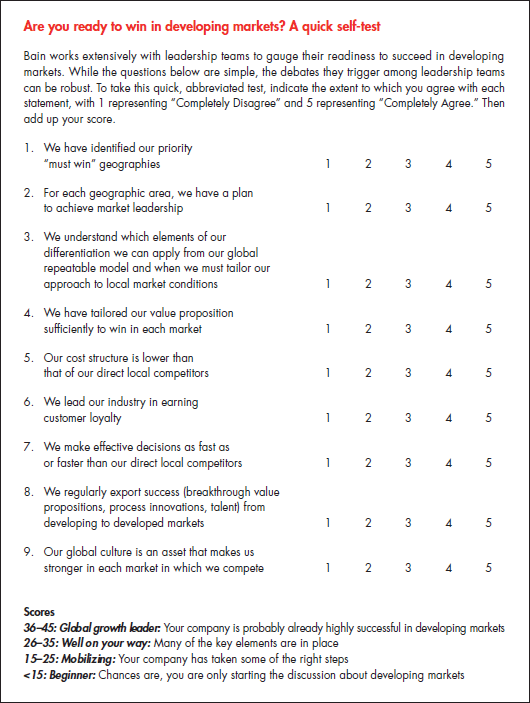Brief
Was it really only three years ago that the company opened its office in this bustling, chaotic country? Seems like half your career. Your team has worked nonstop to understand the regulators, negotiate partnerships, line up suppliers, figure out sales channels and do everything else necessary to grow operations in this fast-developing nation. The growth potential is huge, just as the leadership team knew it would be. But the challenge of scaling up a business here has caught you by surprise. You’re supposed to know how to get things done outside the home country—that’s why you’re here. Still, you’ve had to modify plan after plan, on the fly, to adapt your business model to succeed with local channel partners and customers.
And if you’re honest, that’s not the hardest part. It’s the local competition. At home you’re a market leader, but here you are learning all over again what it means to be a challenger fighting against an entrenched incumbent. The founder’s still in charge at your competitor, and he seems to be working around the clock to drive his business and realize his own audacious ambitions. He’s recognizing and adapting to changes in the local market before you even get the call scheduled to brief your home office. If there was one thing the leadership team underestimated, it was the passion and commitment your competitors bring to the table. And why wouldn’t they? They’re defending their home turf. You’re the interloper. Taking them on is going to be far tougher than anyone imagined.
Most of the executives we talk with at global multinational companies (MNCs) spend a lot of time scrutinizing the developing world. They know about the growth potential. If they’re not already operating in Indonesia or Poland or Nigeria, they’re making plans to do so. What they’re not seeing, often, are the obstacles to success. Most multinationals in developing countries find themselves operating on the far edge of their supply chain and talent pools. Many find it hard to adapt to unfamiliar business practices and customer expectations.
They also find themselves up against a new kind of competitor—nimble, focused, entrepreneurial enterprises, deeply embedded in their home markets, with significant cost advantages, ready access to local talent and often a hard-driving founder. The network infrastructure company Huawei, based in China, was founded in 1987 and is still run by founder Ren Zhengfei as we write this. In 2012 Huawei surpassed Ericsson to become the world’s largest maker of telecommunications equipment—and in the words of one recent report it “threatens firms with histories that stretch back more than a century.” Bajaj Auto, a leading Indian manufacturer of motorbikes and other vehicles, is a third-generation family-run enterprise with a large export business to Africa and Southeast Asia. In 2012 its sales and operating income both rose nearly 20%. As a group, these developing-country superstars are growing faster and more profitably than their global counterparts (see Figure 1). Some are upending whole industries. Anheuser-Busch InBev and SABMiller—two companies with deep roots in developing countries—have transformed the global brewing business, taking market share from competitors in advanced and developing nations alike. ArcelorMittal, the Luxembourg-based multinational with roots in India, has reshaped the global steel industry and is expanding rapidly into developing markets as well as advanced ones. It is already the largest producer in Africa and Brazil.

Building a large-scale business in the developing world—capitalizing on that world’s immense growth opportunities while managing the risks and fierce competitive challenges—is a formidable job. The successful companies typically rely on a clearly defined repeatable model—a unique, easily understood business that can be replicated in one market after another, in new products and new countries and new customer segments, yet retain the simplicity and focus that made it successful in the first place. In particular:
- They balance their ambition for global growth against the complexity of competing in very different markets
- They assess with clear eyes where the strategic opportunities lie
- They meet strength with strength, recognizing their own advantages as a global player and learning how to increase the speed with which they adapt their repeatable model
Are you ready to win in developing markets?
Take our quick self-test to gauge your company's readiness to succeed in developing countries. View
The races in these markets won’t go to the biggest or best-known entrants. They will go to the companies that keep their Repeatable Models® tough, simple and focused, and that follow these precepts. Let’s look at what each one involves.
Balancing global ambition
Every successful strategy, whatever the context, requires a bold, inspiring, full-potential ambition aimed at sustained profitable growth. But a company mapping out its ambition for the developing world must balance this ambition against the complexities of competing in new markets with very different requirements.
A global or a local market? In the conventional view, industries fall into two categories. Some are naturally global in scale. Goods can be produced and sold virtually anywhere in the world with only minor variations—television sets, for example. Others are far more local. Companies in these industries develop assets and capabilities that offer advantages in a local market, and they mostly serve local customers. A natural example is hospitals.
Today, these categories are shifting rapidly. Every year, more supply chains are expanding globally, giving large players a cost advantage. More and more brands are global, spread throughout the world via international media and the Internet. If your business is affected by these trends, you have little choice but to make plans for eventual expansion into developing markets. Stay home, and a global player is likely to force you to the sidelines.
At the same time, some markets are becoming more local. A growing number of countries have local content rules for manufacturers, and consumer-oriented companies find that local tastes create new categories. The much-discussed “next billion” consumers—and the billion after that—won’t look like consumers in the developed world. Most of the first group will be Indian and Chinese, and many of the next group, African. (Total consumer spending in Africa as a whole is already in line with the BRIC countries of Brazil, Russia, India and China and is expected to double by 2020.) These consumers will have far less disposable income than consumers in the developed world. They will have different needs and preferences. They will be accustomed to buying from mom-and-pop stores, roadside kiosks and street stalls. Local companies that understand both customers and channels have a natural advantage over multinationals that are new to the game. To compete successfully, MNCs must find a way to leverage their global advantages, such as technology, brand and global sourcing, while also adapting their repeatable model to deliver what local customers want. Many companies fail to strike this balance successfully.
Revenue growth versus ROCE. Procter & Gamble built a massive presence in China the old-fashioned way: slowly, one joint venture or new product at a time over a period of nearly 25 years. Few companies these days can afford such a long time horizon. And all must balance the long-term revenue objectives that draw them to fast-growth markets with near-term earnings goals such as a robust return on capital employed (ROCE). It takes an estimated eight years, on average, for an investment in China to turn profitable. Other developing markets may require even more time. Existing businesses in advanced nations may not be growing as quickly, but they can generate attractive returns. It is easy to assume that every dollar invested in a developing nation is a dollar diverted from these high-return parts of the business.
The result is often “satisfactory underperformance.” We looked at the performance of 92 MNCs with listed subsidiaries in developing markets. At one level, most of these businesses appear to be success stories: On average, these companies grew profits in their developing market subsidiaries by 15% a year from 2005 to 2010, more than twice the profit growth rate in the rest of the business. However, this 15% profit growth in developing markets still trailed local competitors, which grew profits by 23%. As a group, the global MNCs were not bold enough: They were delivering growth but not investing fast enough to keep pace with local competition in developing markets.
Where to play: Assessing the opportunities realistically
Striking the right balance between global ambition and the complexities of competing in developing markets enables a company to address the two fundamental questions of strategy: where to play and how to win. These two are deeply interrelated and work together to shape any effective strategy.
Still, it can be useful to look at each in turn. In the context of global growth, where to play translates into which countries should we enter? And, where are the most attractive markets for our company, given its unique capabilities and assets?
Any company considering doing business in a new country naturally gathers the standard economic and demographic data: income levels, growth in gross domestic product, consumer expenditures in different segments and so on. It studies channel characteristics, such as how quickly a category is shifting toward a modern distribution system. It investigates infrastructure challenges, hiring practices and other labor relations issues, and the political and regulatory climate.
This information helps determine the attractiveness of a given market. But since all companies look at the same data, it’s really just an initial screen. If this screen looks favorable, a company must then assess how well each potential market fits with its own repeatable model. This may be an attractive market, but is it attractive for us?
Successful management teams ask themselves, for instance, Do we have a ground-level understanding of profit pools? Most developing countries offer the potential of rapid growth. But growth in any market is uneven, and profits sometimes grow slower than revenues. So developing market veterans analyze which specific segments are expanding and then determine whether that growth is likely to deliver long-term profits. They ask whether the growing segments are accessible to them and what the requirements are for leadership. A fast-growing market may not be attractive if it is already crowded with strong competitors or if achieving leadership requires capabilities that a company doesn’t have.
A second question is What is the risk involved? Every company’s assessment of a market’s attractiveness should be unique to that company; it should be strongly influenced by the company’s particular ambition, tempered by its appetite for risk. For example, entering a new country often brings the risk of a binary outcome: either a thriving, profitable business or a dead loss that must be written off. Executives must be prepared to assume that risk. Then, too, markets in developing nations are inherently more volatile than those in advanced countries. It’s like embarking on an ocean voyage: All the stakeholders should expect occasional heavy seas. With growth cooling in several developing markets, many firms are asking if they should reconsider their strategies. The companies that took these risks into account in creating their long-term developing market strategies are more likely to stay the course today and ultimately succeed over the next 10 years.
A third question: Where are the battlegrounds for future innovation? No market exists in isolation. Any one country can be attractive if it adds significantly to a company’s global network, over and above what it might offer as a standalone investment. Developing markets have spawned a multitude of low-cost innovations that might otherwise have flown under the radar of home-country R&D labs. John Deere’s back-to-basics 5003 series tractor, developed and manufactured in India, is now a popular product with small-scale and recreational farmers in the US. Harman International, a $3.8 billion US-based company that is a leader in automobile information and entertainment systems, set up a multinational team based in India and China with a goal of creating simplified products at half the price and one-third the cost of the company’s existing offerings. It then began selling these new products both in developing and developed- world markets.
Evaluating a market, of course, also involves assessing your ability to compete successfully there. The attractiveness of a heavily crowded market, for instance, may depend on your ability to find the right joint venture partner or acquisition candidate, and then successfully execute a deal. And if you build a repeatable model to compete successfully in one market, then a cluster of others may begin looking more attractive than they did before.
So let’s now turn to the other key strategic question: how to win.
How to win: Adaptation
Some companies approach developing markets with a simple strategy: They export their repeatable model intact. Apple distributes essentially the same Macs, iPads and iPhones around the world. It sells them in much the same manner in India or Latin America as it does in the US or Japan. Producers of luxury goods often take this route, too. Companies that choose this strategy, however, generally limit themselves to a relatively small high-end segment of consumers. An Apple iPhone has a great deal of cachet among premium buyers in India, as it does in other countries. But Apple commands only a minuscule portion of the fast-growing Indian market for smartphones, and expanding its share of the market is likely to be a struggle.
So many companies take a different approach: They adapt their business model as they go. But adaptation can be a slippery slope. A company needs to protect the advantages of its model. It can’t reinvent everything for each new market or it will lose the simplicity and focus that led to its success. Then, too, the first move into an adjacent market—a new country, say—may be relatively simple. But the company may then discover that it must adapt its product line. Now it is two steps away from its core business. Each additional move—into new channels, new customer segments and so on—takes it farther from the core, adding complexity and cost and increasing the risk of failure.
Some companies find it possible to adapt just one or two key features of their repeatable model while maintaining the model’s fundamentals. IKEA adopted a new name in China—Yi Jia, which means “pleasant and comfortable home”—and it typically locates its stores in cities rather than suburbs because of the nation’s lower rate of car ownership. But it has maintained the same broad product lines and the same standard store design. In India, McDonald’s spent more than a year developing a paneer burger and other menu items tailored to Indian tastes. But it did not change the basics of its restaurant operations.
The “good enough” segment. Local adaptation often includes learning to compete in the so-called good-enough segment of the market. Historically, this segment included products with prices and performance levels well below the premium products offered by most MNCs. Today, both prices and quality in this segment are increasing. An MNC considering the good-enough segment has to evaluate the size and growth rate of the market it already operates in and its own competitive position, as well as whether good-enough competitors are taking the battle to its home turf. Figure 2 shows the relevant choices—and notes the importance of regularly reevaluating the decision.

The good-enough segment offers one big advantage: A robust good-enough model can provide the basis for entry into multiple developing markets. As Bajaj Auto has discovered with its motorbikes, the same set of products that sells well in Indonesia may also sell well in Nigeria. Still, the dynamics of the segment create significant risks, notably the potential to cannibalize premium products and the requirements of learning to operate a different business model—even, in some cases, with a new and different organization.
The founder’s mentality. One essential part of creating a strategy for developing markets is analytic. It involves the subjects we have just been discussing—how far you can move from your core business, for instance, and where and how you must adapt your repeatable model. But an equally critical part is the ability to see things whole, to inspire and motivate people around a common vision, to build a winning organization. From all appearances, Sony should have emerged as a leader in the integration of information-and-entertainment hardware and software—it held a leading position in most of the relevant areas, including games players, movies and music. But its divisions focused on their own bottom lines, and there was no Steve Jobs to create a vision of integration that every division could contribute to. That left the door wide open for Apple.
In developing markets, multinationals are up against competitors with just such a vision and way of thinking. These competitors are led by hard-driving executives who embody this kind of founder’s mentality, often because the founders themselves are still in charge. For MNCs, the answer often lies in recognizing their own advantages as global players and using these advantages to increase the speed with which they adapt their repeatable model to changing local conditions.
Unilever, for instance, is one of the largest fast-moving consumer goods companies in the world, with revenue of EUR 46 billion in 2011. Some two billion people use its products every day. In the 1980s, the company focused primarily on advanced nations, with only about 20% of its sales coming from developing countries. But then the balance began to shift. By 2000 Unilever’s developing- market revenue was up to 35%; by 2005, 41%; and by 2012, 52%. The company’s strategy is now hitting on all cylinders, and Unilever expects to take in a whopping 70% of its revenues from developing nations by 2020.
Part of Unilever’s secret is its explicit ambition to “straddle the pyramid,” making a diverse array of products that appeal to premium buyers, middle-class consumers and the billions of low-income consumers at the bottom. In India, for example, Hindustan Unilever famously developed a bottom-of-the-pyramid model that included manufacturing personal-care items locally, repackaging them in small sachets that could sell for as little as one rupee (2 cents) each, creating a sales network of local women and partnering with nongovernmental organizations, banks and government agencies to provide credit. The company reached 600 million consumers in rural India by 2010, and the bottom-of-the-pyramid model—known as Project Shakti—was responsible for some EUR 80 million in incremental revenue.
Today Unilever is rolling out similar strategies in Kenya, Indonesia, Vietnam and other countries with conditions similar to India’s—offering five-peso “starter packs” in the Philippines, for example. It is also expanding other businesses throughout the developing world. A repeatable model? “I would almost say that [Unilever’s Africa strategy] is copy-paste,” says one executive. “It’s very much derived from learnings, originally from India, that we perfected in Indonesia, then we even perfected in China, and I’m exactly copy-pasting that best practice into the African market. That gives incredible system strength and competitiveness.” The company’s “Phoenix model” for retail management, for example, “is a repeatable model we use for tracking retail in all the markets where we operate.”
On the ground, Unilever has established links with local universities to get access to talent. It has built customer- insight centers in Singapore and elsewhere, and it has created ambitious leadership development programs, including the first corporate university in Asia. Many of the company’s leaders themselves come from developing nations—some 240 out of the 1,400 top managers working outside India for Unilever, for example, started their careers with Hindustan Unilever. Unilever is shifting its operational base to Asia, with the company’s chief operating officer taking charge of all markets from a headquarters in Singapore. Many of its units now have a distinct developing market focus, with 42% of R&D and 50% of brand development now taking place in the developing world.
And the intangible part? Paul Polman, who became CEO in 2009, mapped out a dramatic vision for the company: doubling revenues by 2020 while cutting the company’s environmental impact in half. This was a commitment to mitigate climate change and to help build a sustainable economy. It has meant encouraging sustainability at every step of the supply chain—reducing the use of nonrenewable resources, increasing recycling, achieving greater productivity while using less water and many other measures. The vision, Polman told Harvard Business Review, is firmly rooted in the history of the company:
“As a company, we have a long history of doing the right thing. When William Lever [later Lord Leverhulme] started the company, in the 19th century, Britain had big hygiene problems. So he invented bar soap—not to make more money, but because in Victorian England one out of two babies didn’t make it past year one. That established the company’s values, and we need to build on them. Before we launched our plan, only 10% of our materials were sourced sustainably. Now, after just one year with new stretch targets, we’re sourcing 24% sustainably.”
In an interview with us, Polman added, “I always talked about the change as rediscovering the greatness of our history. With a company as rich in history and success as Unilever, you can find incredible examples of previous greatness for almost every ambition you have. I became obsessed with the company’s history and was always able to find some moment of brilliant excellence to back up and illustrate the ambitions that we put in place. We weren’t driving change through destruction; we drove change through rediscovery.”
The result of all this is history and vision is a remarkable record of market leadership across categories and countries, and a strong relative market share in many markets (see Figure 3). And it is paying off financially. Unilever’s share price is up more than 25% over the past five years, while the FTSE 100 index is still in negative territory compared with five years ago.

Conclusion: Putting strategy to work
A bold ambition and a clear, well-understood strategy—a strategy reflecting a founder’s vision and showing a clear path to leadership—are the foundation of success in new markets. That’s what we have focused on in this article. But strategy is only one element of what a company needs. Equally important is execution on the ground. In most emerging nations, for instance, the ability to identify, develop and deploy talent effectively is critical. The demand for skilled people far exceeds supply, and if a company doesn’t have a talented team in place before it embarks on a move, it is likely to fail. Unilever has been so successful in part because it has developed—and continues to develop—cadres of international executives from developing nations.
Developing markets present multinational companies with a major—and unavoidable—challenge. The growth potential of these markets is huge. The risks and uncertainties are equally great. Companies that enter a developing market will inevitably encounter turbulence, and some will be scared away. Those that win will be those that understand why they are there, who can adapt and execute a repeatable model, and who can create and implement a bold vision.
Dunigan O’Keeffe leads Bain & Company’s Strategy practice in Asia and the Pacific. James Allen is co-leader of Bain’s Global Strategy practice. They are based in Mumbai and London, respectively.

Repeatable Models® is a registered trademark of Bain & Company, Inc.


